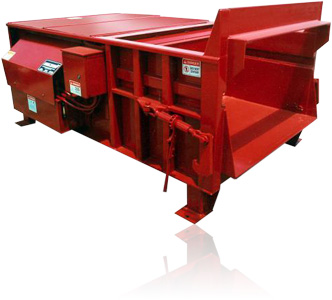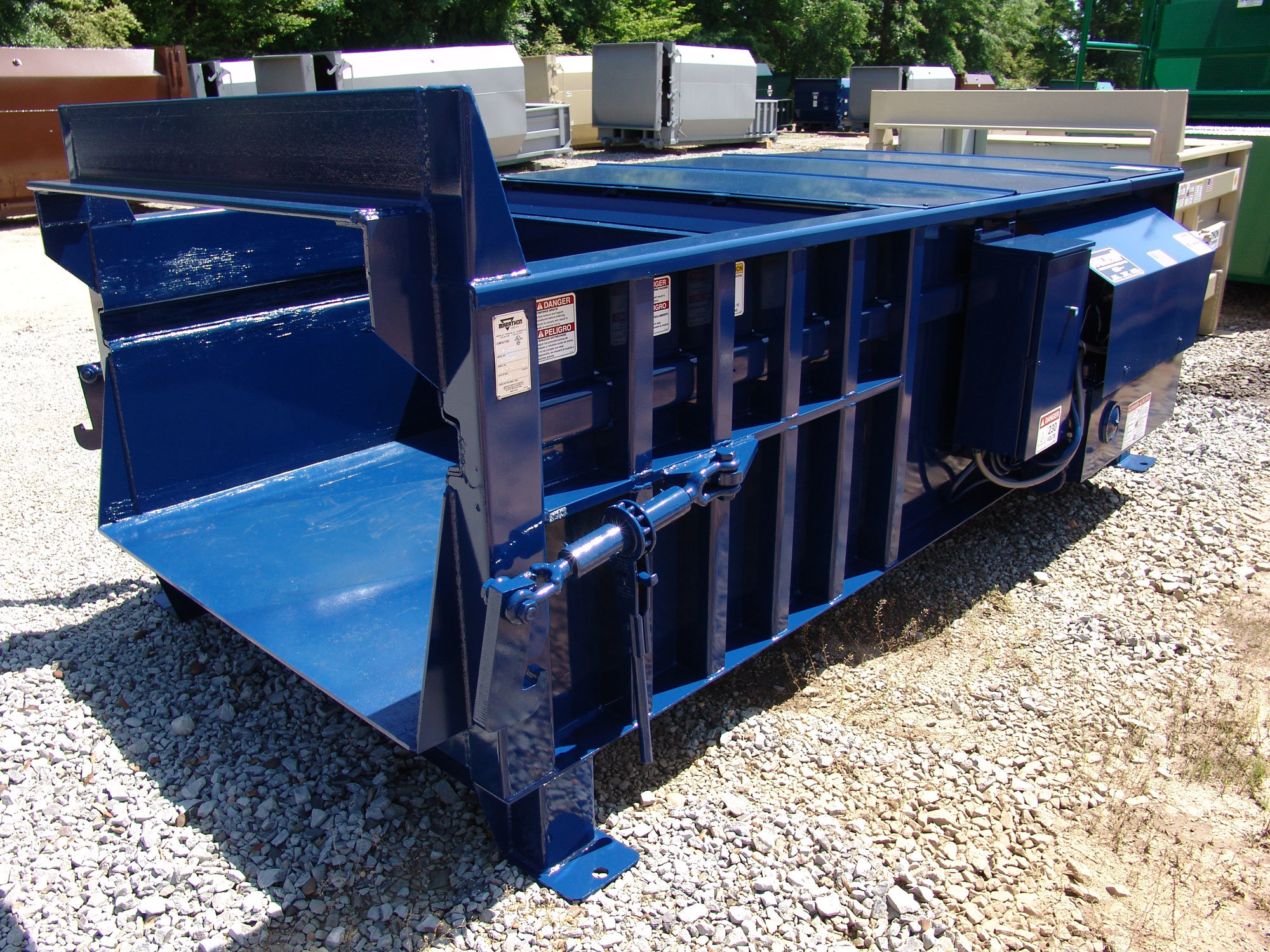Why more companies are choosing Industrial waste compaction equipment today
Comprehending the Numerous Uses Waste Tools in the Recycling Market
The recycling sector depends heavily on specialized waste tools to maximize handling and healing. Each tool, from shredders to balers, serves a distinct purpose that enhances total efficiency. Understanding these roles is vital for enhancing sustainability initiatives. Commercial garbage compaction equipment. As technology developments, new developments emerge, promising to change traditional practices. This advancement elevates vital concerns regarding the future of waste monitoring and its effect on environmental conservation. What changes exist ahead for this critical industry?
The Function of Shredders in Material Handling
Shredders play an essential duty in the recycling market by effectively processing numerous kinds of waste products. These machines are created to decrease large things, such as plastics, steels, and organic waste, right into smaller sized, convenient pieces. This size decrease is necessary for succeeding recycling processes, as it allows for much easier handling and sorting. Along with assisting in recycling, shredders enhance security by minimizing the risk of injury connected with managing large waste items.
In addition, shredders add to ecological sustainability by making sure that products are processed in a manner that takes full advantage of source healing. They can manage a varied series of materials, making them flexible tools in waste administration centers. The effective operation of shredders not just improves the recycling process yet likewise enhances the general effectiveness of waste diversion initiatives, advertising a circular economy. Their relevance in material processing can not be overstated, as they offer as a foundational step in the direction of sustainable waste administration practices.

Exactly How Balers Enhance Performance in Waste Management
Balers significantly improve performance in waste management by compacting various materials right into bales, which streamlines storage and transportation. By pressing recyclables such as cardboard, plastics, and steels, balers substantially reduce the volume of waste. This compression not only makes best use of area in reusing facilities however additionally decreases the number of trips called for to move products, bring about lower gas expenses and decreased ecological impact.
Additionally, balers contribute to improved safety in waste administration procedures. Small bales are easier to deal with and stack, lowering the risk of accidents related to loosened materials. The uniform size of bales enables much more efficient loading and unloading processes, enhancing procedures within reusing facilities. Furthermore, balers can boost the overall high quality of recyclables, as effectively compressed products are much less likely to be polluted. In general, balers play an essential function in maximizing waste monitoring techniques, promoting sustainability in the recycling market.
Conveyor Systems: Simplifying the Recycling Refine
Integrating innovative machinery like balers significantly enhances waste administration procedures, but the effectiveness of the recycling process is even more boosted via making use of conveyor systems. These systems play an essential function in the seamless transport of products within reusing facilities. By visit the site assisting in the activity of various waste types, conveyor systems lessen hands-on handling and lower the danger More hints of contamination throughout the recycling procedure.
Conveyor systems can be personalized to fit the special formats and operational needs of reusing facilities. Their capability to operate continuously permits a consistent flow of materials, improving performance and making certain that sorting and refining devices receives a consistent supply.
Equipped with attributes like flexible speeds and automated controls, conveyor systems can maximize the flow of materials, substantially improving overall effectiveness (Commercial garbage compaction equipment). Subsequently, these systems are essential in contemporary recycling operations, improving processes and adding to effective waste monitoring
Sorting Makers: The Key to Product Recuperation
Arranging makers are important components in the reusing industry, substantially boosting the efficiency of product recuperation. These equipments play a pivotal role in the separation of various recyclable materials, permitting a structured procedure that makes the most of source removal. By making use of advanced modern technologies, such as optical sensing units and air classifiers, arranging devices can identify and classify materials based upon their size, weight, and make-up. This capacity ensures that steels, plastics, and paper items are properly isolated, reducing contamination and improving the quality of recycled result.
The operation of sorting machines considerably minimizes the reliance on manual work, which can be both vulnerable and taxing to mistakes - Commercial garbage compaction equipment. Furthermore, the automation provided by these makers increases the total recycling procedure, causing higher throughput and boosted functional efficiency. Sorting equipments are indispensable in attaining lasting waste monitoring goals, enabling the recycling industry to efficiently recuperate important products while decreasing landfill reliance.
Advancements in Waste Equipment for a Lasting Future
Recent advancements in waste devices are driving the recycling industry toward a much more lasting future. Innovations such as automated arranging systems, which make use of expert system and artificial intelligence, enhance performance by accurately recognizing and separating recyclables. This leads to higher recuperation rates and minimized contamination. In addition, advancements in condensing modern technology enable extra efficient transport of products, reducing i thought about this carbon footprints throughout transit.
Improvements in shredding devices improve the processing of complicated materials, allowing the recycling of items that were when considered non-recyclable. The integration of renewable resource resources, like solar energy, in waste processing centers additionally adds to sustainability objectives. In addition, developments in biodegradable materials and waste-to-energy innovations are reshaping the landscape of waste administration. Jointly, these improvements represent a transformative shift within the recycling market, advertising not just environmental management but also financial feasibility for future generations.
Frequently Asked Questions
What Kinds Of Materials Can Waste Equipment Take Care Of?
The kinds of materials waste equipment can take care of include plastics, steels, paper, glass, and natural waste. Each devices type is made for particular materials, optimizing efficiency and performance in arranging and processing different waste streams.
Exactly How Typically Should Waste Devices Be Preserved?

Are There Security Interest In Utilizing Waste Tools?
Safety and security concerns with utilizing waste devices include potential injuries from mechanical breakdowns, direct exposure to unsafe materials, and inadequate training. Appropriate upkeep, regular evaluations, and worker education are important to mitigate these threats successfully in any type of setting.
What Is the Average Life Expectancy of Recycling Equipment?
The ordinary life expectancy of reusing equipment typically ranges from 10 to twenty years, depending on variables such as use strength, upkeep practices, and technical innovations, which can substantially affect sturdiness and performance with time.
Just How Is Waste Devices Powered in Recycling Facilities?
Waste devices in recycling centers is commonly powered by power, though some equipments might utilize different power resources like natural gas or diesel. This power allows reliable handling and improvement of products for recycling purposes.
Shredders play a crucial function in the recycling market by efficiently refining different kinds of waste products. They can take care of a varied variety of materials, making them versatile devices in waste administration centers. Balers significantly improve performance in waste monitoring by compacting different products right into bales, which simplifies storage and transport. The kinds of products waste devices can manage consist of plastics, steels, paper, glass, and organic waste. Security problems with using waste equipment include potential injuries from mechanical breakdowns, exposure to unsafe materials, and poor training.